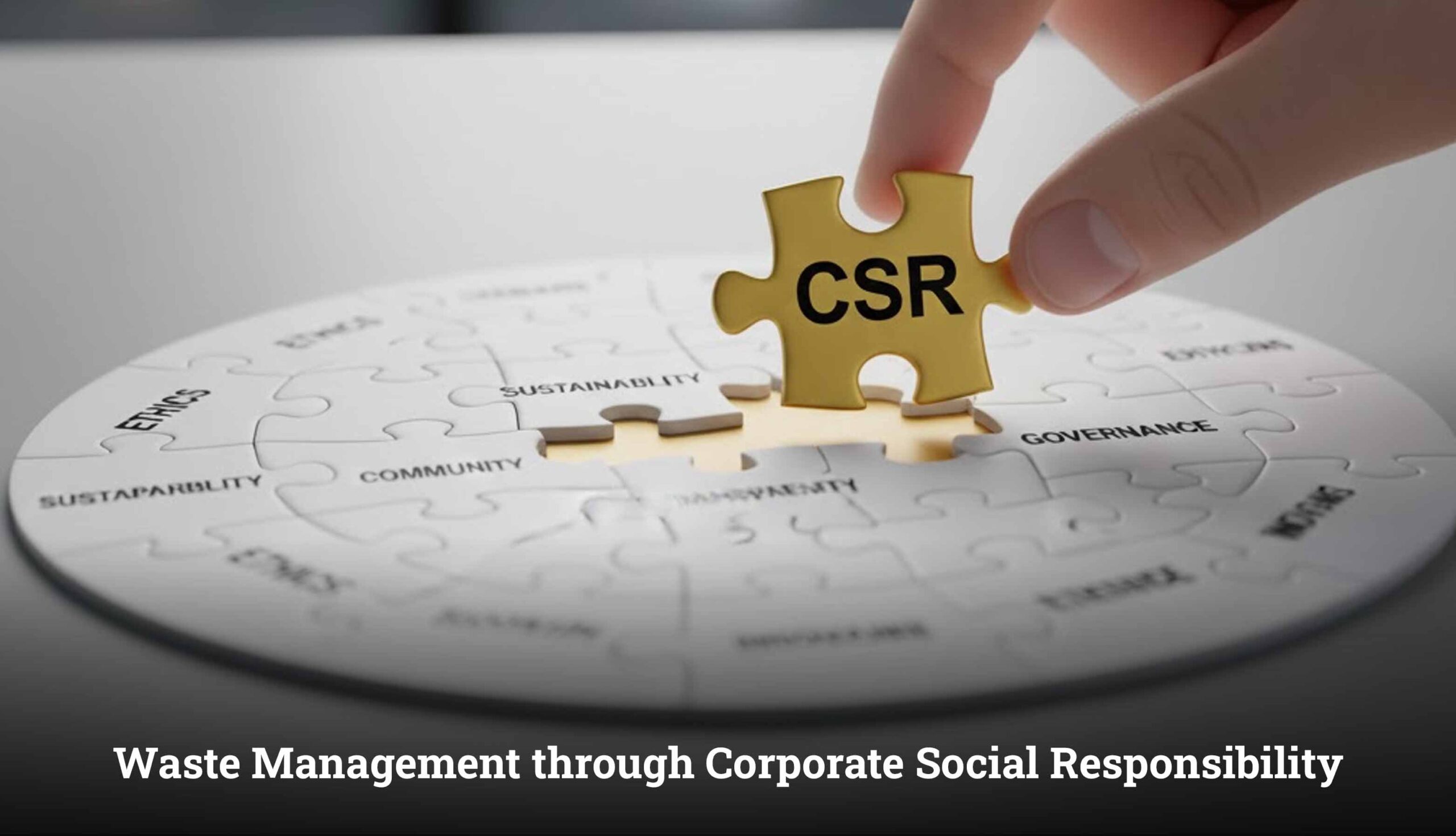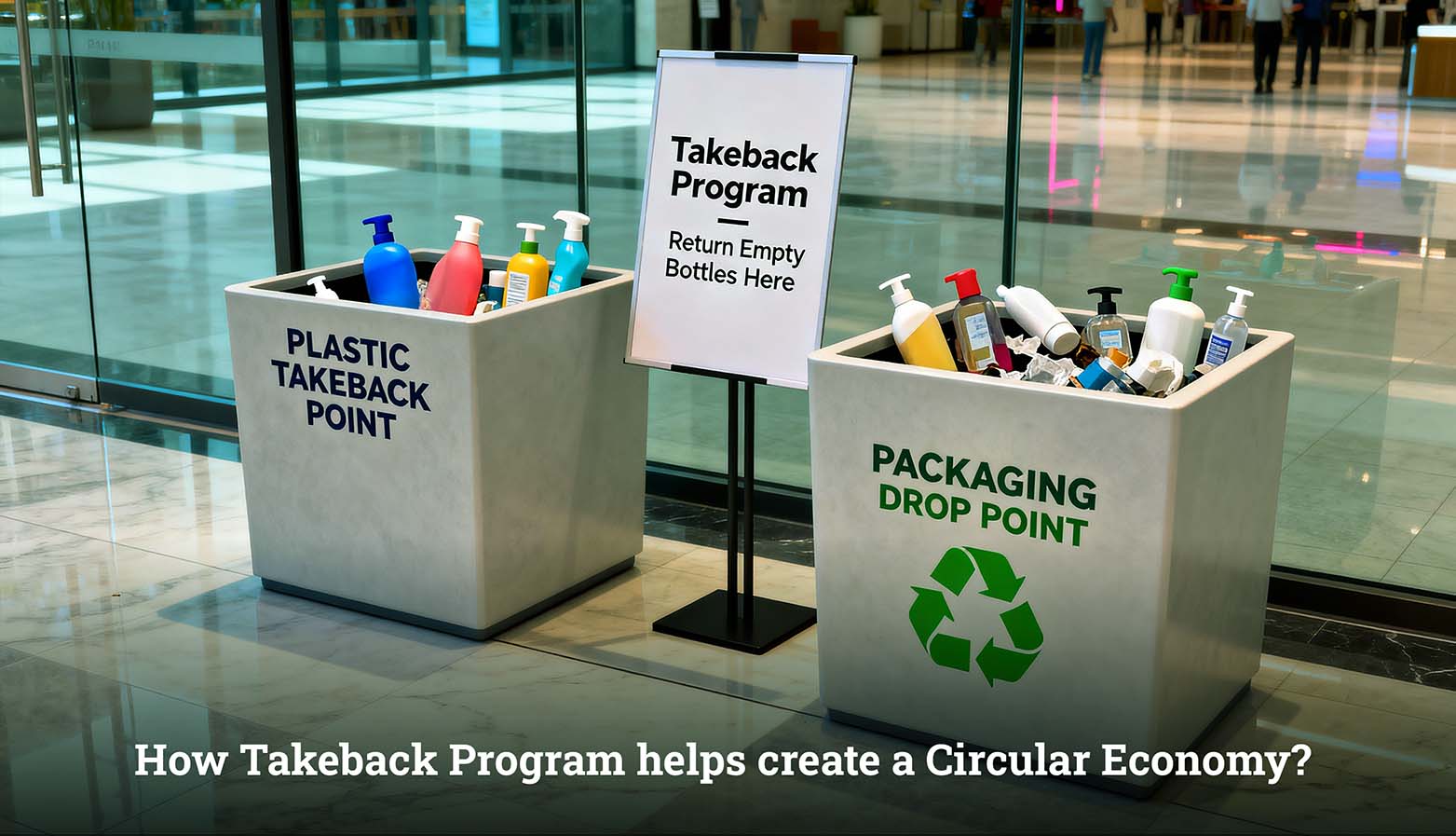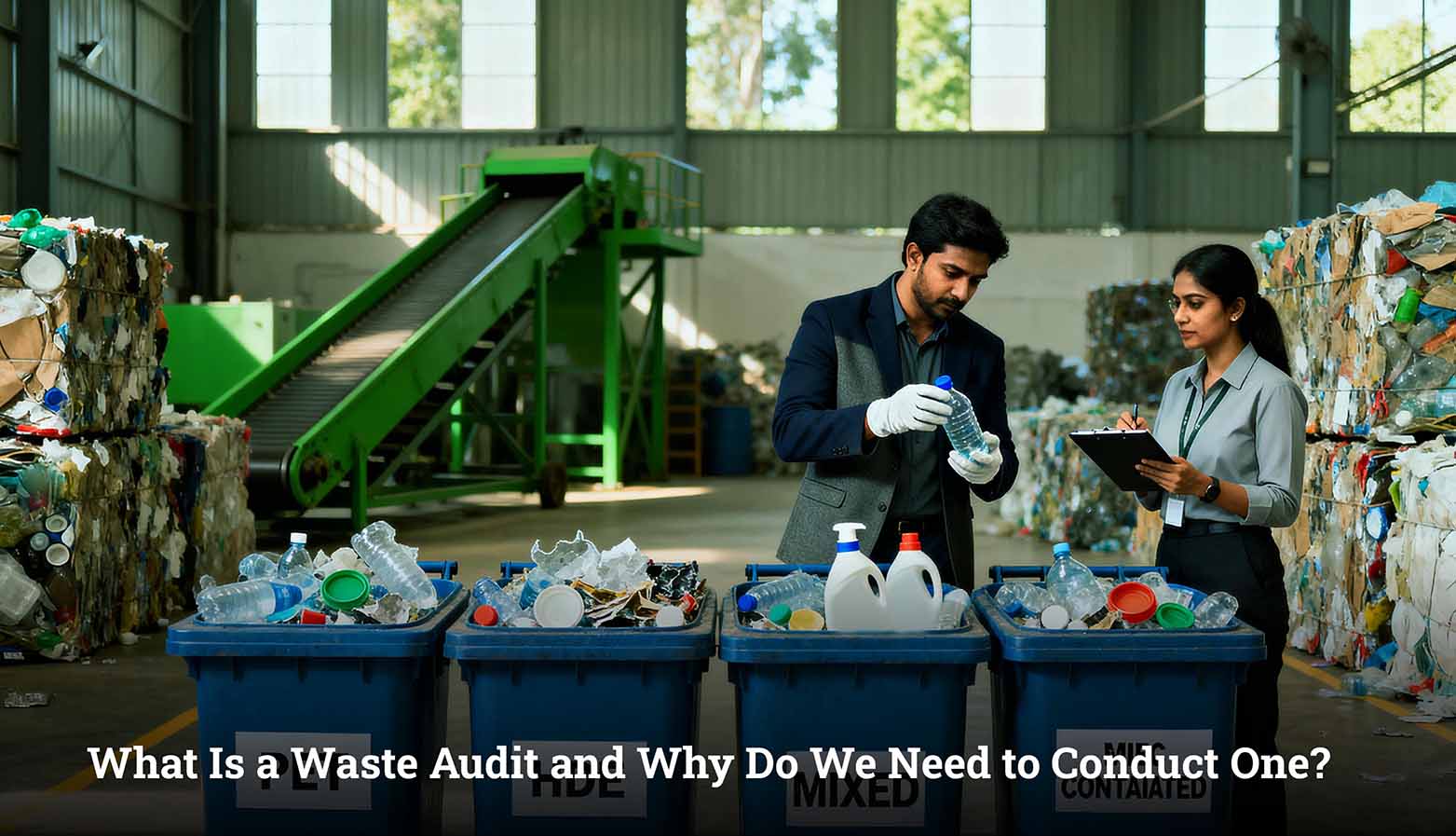The environmental challenges our planet is facing have been unprecedented. Whether it’s the air we breathe, water we drink and soil we till; all the indicators of environmental degradation are getting much more evident. We see it with the increasing intensity of weather extremes, the worrying loss of biodiversity, and also the pollution all around us that mars and defiles our natural environment. The problems are interrelated by the fact that they arise as a result of a complex interdependence of human practices and are not just abstract threats, but generate real life-span and potentially devastating effects on both biotic and abiotic environments, human health, and the general stability of our planet. It is important to understand the underlying factors contributing to such a decline including un-sustainable consumption trends, industrial processes and poor waste disposal mechanisms when seeking solutions to the problems. Out of this broad range of solutions which are focused on attenuating these negative impacts, the concept of recycling proves to be one of the most powerful and easily applicable weapons. Viewing waste as a resource, recycling provides an objective solution toward reducing pressure on the relative limited resources of planet Earth, reducing pollution, and narrowing the gap toward a more circular and sustainable economic interaction with our environment. The strength of recycling is that it will hit on many aspects of environmental degradation, hence a necessary addition to a larger effort to treat the planet’s health.
Introduction
The reasons for degradation of environment are multidimensional, starting with the emission of industrial pollutants, degrading forests to the over-farmed lands, and the number of garbage being produced by an expanding world population. The result of this regression takes a number of forms with fragile balances in our eco systems being affected and vital resources to life being threatened. It is time to take a careful reflection on the disturbing implications of environmental degradation. This is a start to execute the relevant measures that will change these poor trends.
What is Environmental Degradation?
Environmental degradation refers to the deterioration of the living environment. The reasons for degradation of the environment are due to depleting means of survival like air, water, and soil; destruction of habitat; extinction of wildlife and the pollutants.
- It indicates deterioration of an environment, which can sustain life and ecological functions, to a lesser extent.
- It includes a vast extent of malefic influence on nature.
- It decreases the environmental capability of satisfying demands of living things. It is often caused by unsustainable human activities.
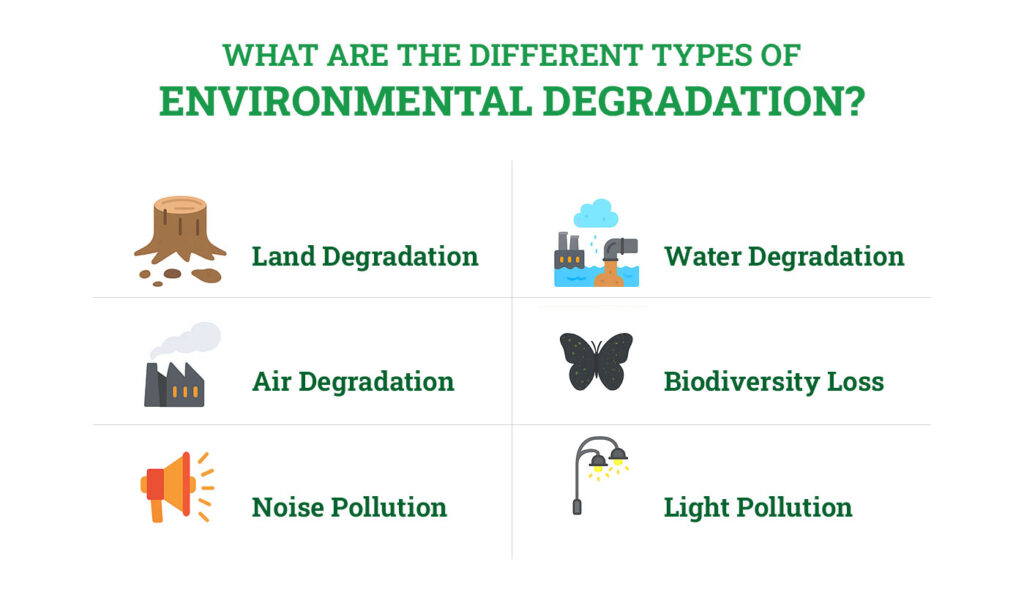
What are the Different Types of Environmental Degradation?
The consequences of environmental degradation are varied of course, and they differ in terms of reasons for degradation of environment
Land Degradation
This comprises deforestation, soil eros physiology, desertification and soil pollution by pollutants.
Water Degradation
Contamination of rivers, lakes, oceans, and groundwater with industrial waste, runoff water, and sewage, and plastic trash.
Air Degradation
The emission of the pollutants and small particles into the air resulting in smog, acid rain and breathing difficulties.
Biodiversity Loss
The decreased number of life on Earth, including the extinction of flora and fauna species as a result of ecological destruction and much more.
Noise Pollution
This is extreme noise caused by transport, construction and industrial work which may be detrimental to the health of people and animals.
Light Pollution
Unnecessary artificial light which interferes with natural changes and life.
Major Causes Behind Environmental Degradation
There are some main determinants for environmental degradation types depending on the impact of environment degradation:
Industrial Activities
Chemical processes that are involved in manufacturing frequently contaminate the air and water, and harvesting of raw materials has the possibility of destroying habitats.
Deforestation
The impact of environment degradation due to forest land being cut down to facilitate agriculture, urbanization or logging occasions, decreases biodiversity, causeing soil erosion and emits carbon dioxide to the atmosphere.
Pollution
The consequences of environmental degradation due to pollution is the contamination of the environment by different pollutants such as plastic litter, chemical emissions, and greenhouse gas among others.
Un-sustainable agriculture
Monoculture, overuse of fertilizers and pesticides, intensive farming of livestock have potential to destroy the soil and contaminate water sources.
Overpopulation and Consumption
The world today is experiencing an ever-swelling population with unsustainable patterns of consumption, which is exerting a heavy strain on the available natural resources, and creating more waste.
Climate Change
Increased global temperature and change in the weather pattern enhance most environmental degradation types including desertification, rising sea levels and catastrophic weather.
What are the Consequences and Impact of Environmental Degradation
The consequences of environmental degradation and environmental degradation examples are too many and its effects are far-reaching:
Biodiversity loss
Species extinction causes ecosystem imbalances and a decline in the stability of the natural environment.
Climate Change Strengthening
Deforestation and emission of greenhouse gases are enhancing global warming.
Resource Scarcity
The exhaustion of freshwater, fertile soils, etc. poses danger to human lives and the economy.
Effects to Human Health
Pollution of the air and water are environmental degradation examples that leads to cases of respiratory diseases, cardiovascular diseases among other health disorders.
Economic Losses
The economic losses that can be experienced as a result of environmental harm include a reduction in agricultural profits, destruction of infrastructure and the loss of tourism.
Displacement and Migration
Climate change can encourage displacement, including due to rising water levels and desertification and cause people to be displaced out of their homes.
How Recycling is the Solution to Environmental Degradations
Recycling is one of the most helpful solutions to environmental degradation:
Preservation of Natural Resources
Recycling also eliminates the need to locate new resources on the earth; since the resources are reused, there is little or no destruction of habitats, cutting down of trees and energy used to mine and harvest these raw materials.
Less energy use
The production of goods that are using recycled materials will also use much less energy than the manufacturing of materials that are using raw ones, hence a reduction in greenhouse gases emission and fossil fuel addiction.
Reduction in the use of Landfills
Recycling saves tremendous volumes of waste material entering into the landfills, saving down-to-earth and allowing less potential pollution of soil and underground waters via leachate.
Pollution
It has been found that recycling can lead to a reduced level of air and water pollution than manufacturing using virgin materials. As an illustration, aluminum recycling decreases air pollution by 95 percent and 97 percent water pollution as compared to making it out of bauxite ore.
Climate Change Mitigation
Through regulation of energy usage and green house gasses releasing, recycling is a key solution to environmental degradation. An example is the fact that the environmental cost of plastic recycling reduces the carbon emissions by a considerable margin as opposed to virgin plastic production.
Environmental Impacts of Recycling
The positive effects of recycling on the environment are
Reduced Greenhouse Gas Emissions
Dump Gilbert when you reduce your energy use, this directly correlates to reduced climate change-causing emissions.
Limited Resources
Recycling helps to save good natural resources that could be resourceful to future generations.
Less pollution
Fewer things in landfills means there is a lower production of methane, and less energy consumption levels also translate to less air and water pollution.
Job Creation
Recycling clothes reduces unemployment through creating jobs in collection processes, processing and manufacturing.
Conclusion
Environmental degradation is a topic that needs serious intervention and complete actions. Although many strategies are necessary, recycling is one easily accessible and effective means of curbing the negative impact of its damaging presence. The implementation and spreading of recycling efforts are a sure way to put less pressure on the resources that we have on earth and make our world cleaner with less pollution and an able world to live in. It is important to understand that there is an overwhelmingly deep linkage between sustainable waste management and the health of the planet and our attempts to reverse the environmental degradation trend.
FAQ's
What are some examples of severe environmental degradation?
Examples include the deforestation of the Amazon rainforest, plastic pollution in the Great Pacific Garbage Patch, air pollution in major industrial cities, and the depletion of aquifers due to over-extraction.
What are the effects of environmental degradation on human health?
xposure to pollutants from environmental degradation can lead to respiratory illnesses, cardiovascular problems, cancers, developmental issues, and infectious diseases.
How does climate change relate to environmental degradation?
Climate change acts as a significant driver and amplifier of environmental degradation, exacerbating some challenges of environmental degradation like sea-level rise, extreme weather events, droughts, and biodiversity loss.
Making recycled packaging the norm.
CITATIONS:
- United States Environmental Protection Agency. (n.d.). Benefits of Recycling .Retrieved from
https://www.epa.gov/recycle/benefits-recycling - https://cpcb.nic.in/annual-report.php
- Open Knowledge Repository.(n.d.).
https://openknowledge.worldbank.org/entities/publication/d3f9d45e-115f-559b-b14f-28552410e90a - Recycling Basics and Benefits | US EPA.(2025, August 6). US EPA.
https://www.epa.gov/recycle/recycling-basics-and-benefits


 The Role of CSR (Corporate Social Responsibility) in Waste Management
The Role of CSR (Corporate Social Responsibility) in Waste Management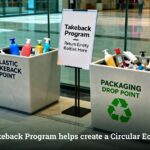 What is Takeback Program & Their Role in Building a Circular Economy
What is Takeback Program & Their Role in Building a Circular Economy What Is a Waste Audit and Why Should Recycling Companies Conduct One?
What Is a Waste Audit and Why Should Recycling Companies Conduct One? How Greenwashing Affects Plastic Recycling?
How Greenwashing Affects Plastic Recycling? What is Polypropylene Plastic?
What is Polypropylene Plastic?